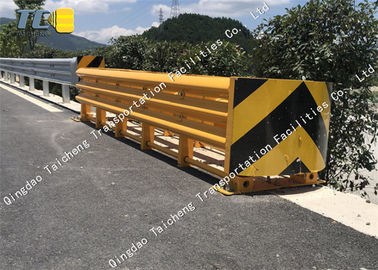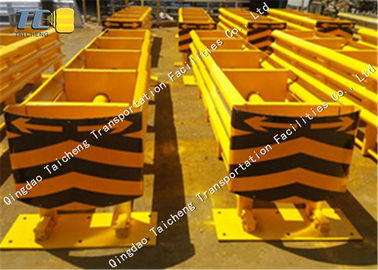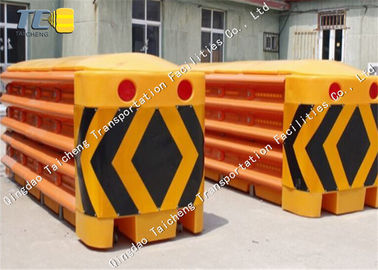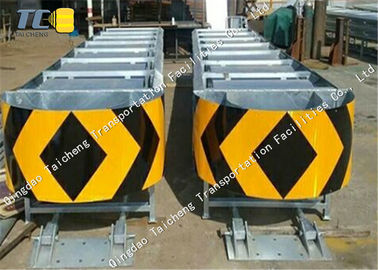

|
|





| Brand Name: | Tai Cheng |
| Model Number: | CCA |
| MOQ: | 50m |
| Price: | 1200 USD per meter |
| Payment Terms: | L/C, D/A, D/P, T/T, Western Union, MoneyGram |
| Supply Ability: | 12-15km per month |
Qingdao Taicheng Transportation Facilities Co., Ltd
The first manufacturer of exporting new type roller barriers in China
Qingdao Taicheng Transportation Facilities Co., Ltd. is a technological innovation enterprise invested by Henger Group. Its headquarters is located in Jinkou Industrial Park, Qingdao. Taicheng Transportation has an innovative scientific research team, advanced manufacturing technology, first-class production facilities, and perfect testing methods. , reliable product quality, enthusiastic after-sales service, devoted to the great cause of improving China's road safety.
![]()
The company will always adhere to the corporate tenet of "not forgetting the original intention, people-oriented, and technological innovation", to build a first-class transportation facility enterprise with international competitiveness, to provide the society with high-quality new rotating anti-collision guardrails, and to protect the road safety of the country and the world. convoy.
![]()
![]()
Product description
There are many types of anti-collision pads. According to the anti-collision principle, they can be divided into two categories: kinetic energy principle and momentum conservation principle. The kinetic energy principle crash pad is a destructible or plastically deformable material or structure placed in front of the crash object. To absorb the kinetic energy of a moving vehicle through buffering or energy absorption, this structure needs to be rigidly supported or blocked to deform the energy-absorbing material or structure to reduce the impact force on the vehicle. The other is a structure that, in accordance with the law of conservation of momentum, transfers the momentum of the out-of-control vehicle through some sand and water containers placed in front of the anti-collision object to play a buffering role. This structure has strong construction maneuverability and is more convenient to apply.
![]()
Road crash pads
Anti-collision pads are facilities that absorb vehicle collision energy to stop the vehicle safely or smoothly to avoid serious injuries to drivers and passengers. They are divided into guideable anti-collision pads and non-guided anti-collision pads according to their functions. Crash pads are low cost and have high safety performance. It is mainly used in the exit triangle area of highways or urban roads, the front end of toll islands, and the front end of other obstacles such as tunnel openings. There are many forms of energy absorption for anti-collision pads, most of which rely on physical energy absorption, such as rubber, sand, etc. The more reliable energy absorption is the deformation of steel. Practice has proved that the crash pad is an effective facility. It mainly reduces the severity of accidents rather than reducing the occurrence of accidents.
![]()
![]()
Structure of the guideable crash pad
Guideable crash pads generally consist of ends, energy-absorbing materials, guard beams on both sides, diaphragms and back supports. After the vehicle collides with the crash pad, the energy of the collision vehicle is absorbed through the deformation and energy-absorbing material of the end part, and the back support is used to resist the impact of the vehicle. Energy-absorbing materials are generally foam materials or rubber materials. Anti-collision pads based on this principle have good energy-absorbing and guiding effects for both front and side collisions of vehicles. Moreover, the main components of the system can be reused after a collision. . Therefore, maintenance is convenient, fast and low-cost. The disadvantage is that the initial installation is slightly complicated and costly.
The principle of conservation of momentum of the steerable crash pad is generally composed of sand-filled or water-filled anti-collision tubes (piers) of different masses arranged in a certain order. After the vehicle collides with the crash pad, the momentum of the vehicle is transferred to the anti-collision tube in turn. Reduce the speed of the vehicle and the anti-collision tube in sequence, so that the speed of the vehicle drops below 15km/h.
![]()
![]()
Highway guideable crash pads should have both front-impact compression and energy-absorbing functions and side-impact blocking and guiding functions. In order to realize the blocking and guiding function of the anti-collision pad during a side impact, a guide plate is provided on the side of the anti-collision pad to enhance the lateral stiffness of the anti-collision pad. A guide slide rail is provided at the bottom to control the anti-collision pad to move along a certain trajectory after a vehicle collision, while preventing it from deviating too far and causing interference to the normal operation of the vehicle. In order to realize the compression and energy-absorbing function during a frontal collision, the guideable anti-collision pad is set into a multi-section structure, and an energy-absorbing barrel is installed inside each section to reduce the damage to the passenger car and its passengers in an instantaneous collision. At the same time, the guide plate is equipped with a chute so that it can be compressed smoothly in the event of a frontal collision.
![]()
![]()
Compared with ordinary anti-collision pads, their high temperature resistance and aging resistance have been enhanced. The anti-collision level can be selected from three levels: TA/TB/TS according to needs. The guideable anti-collision pad enhances the guidance performance and energy-absorbing buffering performance while ensuring the anti-collision performance. When a vehicle loses control and collides with this area, due to the performance of the anti-collision pad, the driving direction can be corrected in time and most of the collision energy can be eliminated, thereby ensuring the safety of drivers and passengers and the vehicle. The anti-collision pad is also affixed with reflective strips. When driving at night, the light can better show the diversion contour and play a good role in guiding the vehicle's sight.
The guideable anti-collision pad is suitable for being installed at the diverging end of the main line of the highway (expressway, main road), the end of the guardrail at the ramp exit, the end of the diversion island of the toll station, the end of the guardrail of the central separation belt, and the end of the opening of the central separation belt. As well as the ends of the middle piers of highway spans, the ends of concrete guardrails, tunnel openings, and the front ends of structures that are prone to impact damage when struck by vehicles.
![]()
Product features
1. Beautiful appearance
A variety of colors can be selected for assembly, which can coordinate with the surrounding environment and are beautiful but not obtrusive.
2. Weathering durability
Waterproof, moisture-proof, anti-corrosion, wear-resistant, high temperature resistance, acid and alkali resistance and other advantages.
3. Sufficient inventory
With sufficient product inventory, consumers can order products with confidence and we will deliver them in a timely manner.
4. Various styles, support customization
The products are available in various styles and colors and support customization.
![]()
![]()
The guideable anti-collision pad can be coordinated with the standard section form of the connected guardrail for safe and reliable connection.
Guideable anti-collision pads can be applied to road sections such as the three corners of highway off-ramps, tunnel entrances, toll island fronts, and independent bridge piers.
![]()
In accordance with the tolerant design concept, a large safety margin is reserved. It adopts a modular design and is easy to install. The energy-absorbing components can be partially replaced and used, and the maintenance cost is low.
The guideable crash pad is composed of a peripheral guide plate and an internal energy-absorbing device. Its dimensions are 2470/3910/5350 in
length, 860 in height, and 1050 in width.
![]()
The anti-collision level is TB/TA/TS level, with simple installation and beautiful appearance. It is suitable for installation at the diverter end of the highway main line, the diverter end of the ramp, the entrance of the tunnel and the diversion dense end of the toll station.
![]()
![]()
How to install highway crash pad?
Highway crash pads are quick and easy to install. Highway steerable crash pads come fully assembled at the factory. In its transportation and distribution process, the method adopted is overall loading and unloading. After arriving at the site, workers can directly install the anti-collision pads.
During installation, you only need to drill corresponding bolt holes in the road surface and inject reinforcement glue. Then insert the anchor bolts into the holes and tighten the nuts after the reinforcement glue has solidified to complete the installation.
This method reduces the installation process, greatly shortens the installation time, and improves work efficiency. Moreover, the construction road can be turned into a safe area as soon as possible.
![]()
![]()
Our advantages
1. Our products have obtained CCS, ISO certificates.
2. We will provide exclusive sales services to each customer and respond to customer questions as soon as possible.
3. We can provide samples for customers to refer to the style and model of the product.
4. We can customize products according to customer needs.
5. We will update you on product production progress in a timely manner.
6. We accept customer factory inspections and third-party factory inspections.
7. We can provide you with good after-sales guarantee.
![]()